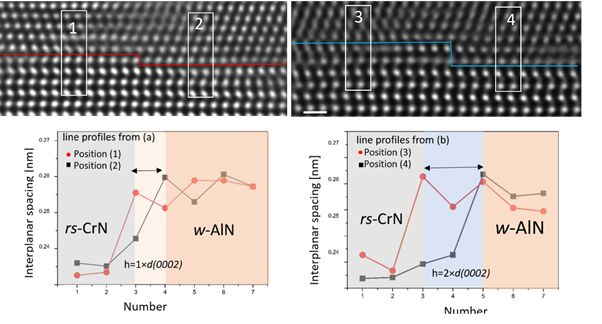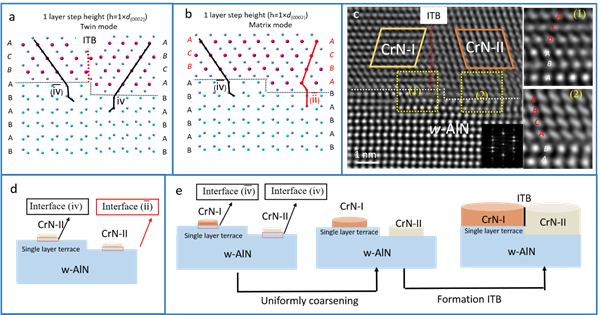Growth-twins in CrN/AlN multilayers induced by hetero-phase interfaces
- Abstract number
- 1082
- Event
- European Microscopy Congress 2020
- DOI
- 10.22443/rms.emc2020.1082
- Corresponding Email
- [email protected]
- Session
- PSA.2 - Metals & Alloys
- Authors
- Zhuo Chen (3), QinQin Shao (2, 3), Dr. Matthias Bartosik (4), Prof. Dr. Paul H. Mayrhofer (4), Dr. Zaoli Zhang (1)
- Affiliations
-
1. 1Erich Schmid Institute of Materials Science, Austrian Academy of Sciences
2. Center for High-Resolution Electron Microscopy, College of Materials Science and Engineering, Hunan University
3. Erich Schmid Institute of Materials Science, Austrian Academy of Sciences
4. Institute of Materials Science and Technology, TU Wien
- Keywords
interface; growth-twins; high-resolution transmission electron microscopy; interface terrace
- Abstract text
We carry out a characterized in detail with a spherical aberration-corrected high-resolution transmission electron microscopy (HRTEM) and associated techniques (i.e. quantitative analysis etc..), STEM as well as dark-field transmission electron microscopy (TEM) in a high stacking-fault energy transition-metal nitride (TMN) multilayer. Based on the HRTEM observations and atomic model analyses, supplemented with theoretical calculations, several nucleation modes of twins with Σ3 {112} ITB and Σ3 {111} CTB are proposed.
Twin boundaries with Σ3{111} and Σ3{112} are often observed in low stacking-fault energy (SFE) fcc (face-centered cubic) materials. Nano-twins with Σ3{111} coherent twin boundary (CTB) can improve strength, ductility, electrical conductivity and thermal stability. Σ3{112} incoherent twin boundaries (ITBs) have been found to play crucial roles in plastic deformation and de-twinning process in nano-twins metallic materials. Transition-metal nitrides (TMN) are perspective hard coating material were applied to molds, punch, cutting tools and other machine parts to improve their wear, corrosion resistance and mechanical. TMN ceramics are often limited by their poor ductility and plasticity. To further improve the ductility and plasticity of transition-metal nitrides, twinning as a new approach will be gradually studied. However, twinning of transition-metal nitrides (TMN) is difficult. This could be attributed to the high SFEs of transition metal nitrides.
The morphology of the film was examined by bright/dark-field imaging and selected-area electron diffraction (SAED) using a Philips CM12 transmission electron microscope working at an accelerating voltage of 120 kV. A 200 kV field emission TEM/STEM (JEOL2100F) equipped with an image-side CS-corrector was used in this study.
Since the AlN phase stability is thickness-dependent, two different phases can be readily detected in the gradient multilayer [1], i.e. metastable rock-salt AlN and stable wurtzite AlN. In this work [2], a high-density of rock-salt TMN twins with Σ3{112} incoherent twin boundaries (ITB) were found in the {111} rock-salt CrN ||{0002} wurtzite AlN hetero-phase interface. The extensive high-resolution transmission electron microscopy (HRTEM) observations reveal that rock-salt TMN twins with ITBs are frequently formed in wurtzite {0002} interface with a single-atomic-layer terrace (1×d{0002}w-AlN). However, twins with ITBs were hardly observed in the wurtzite {0002} interface with a double atomic-layer terrace (Figs.1). Combined with the experiment observation, DFT calculation and kinetics of, the formation of twins with ITBs can be interpreted by the rs-CrN/w-AlN interface structure (with a mirror-symmetry)-induced thermodynamically stable nucleation (Figs.2). Furthermore, we see that the growth-twins with Σ3{111} coherent twin boundaries (CTB) appear in the non-textured film area further away from the substrate. Due to the interface orientation variation, two twin nucleation modes with different misorientation angle of growth direction for Σ3{111} CTB were found.
In conclusion, the atomic-resolved images of rs-CrN{111}||w-AlN{0002} interfaces reveal that a single-atomic-layer terrace is closely associated with the formation of such growth-induced twin formations. The hetero-phase interface-facilitating nucleation process plays a dominant role in rock-salt growth-twins, which findings offer a new perspective on the formation mechanism of growth-twins in transition-metal nitride materials.
Figs.1 HRTEM observation the terrace structure in the rs-CrN/w-AlN interface. The twins with ITBs can be found in single atomic-layer terrace. In double atomic-layer terrace, there is no twin detected in the CrN layers. The line profiles result quantitative show the interface with different step height.
Fig. 2. (a) Schematic of the {111}rs-CrN||{0002}w-AlN stacking structure of matrix mode CrN growth on single-layer terrace w-AlN. (b) Schematic of the {111}rs-CrN||{0002}w-AlN stacking structure of twin mode CrN growth on single-layer terrace w-AlN. (c) HRTEM image shows rs-CrN twins with ITBs grown on the w-AlN {0002} surface, in which a single atomic-layer terrace (h=1×d{0002}w-AlN ) of w-AlN can be found. Two enlarged atomic resolution images of the interface stacking are inserted on the right-hand side. The Σ3 {112} ITB is marked with a red dotted-line. (d) Schematics illustrating the nucleation process on single-layer terrace w-AlN.
- References


